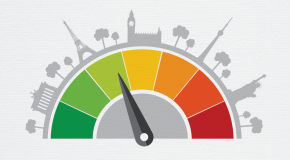The fuels we currently use for power generation are not sustainable, but what can replace them? Coal emits the most carbon and is the most urgent problem. Natural gas is expensive and still has too much carbon to be a long-term solution. Nuclear power is unpopular. So surely renewable energy, if it is feasible, would be the answer. Well, maybe, but more and more people object to wind turbines intruding on the countryside and the debate seems to be turning into a shouting match between advocates and sceptics.
So let us start by asking how much wind and solar power could realistically contribute to decarbonising electricity supply. There is a certainly vast quantity of energy in the wind and in solar radiation, but how much of it can we convert into electricity? Is it worth the effort?
It turns out that a typical wind farm will produce, on average, around 2 watts of electricity per square metre of land. Solar photovoltaics do somewhat better at around 5 watts/m2. These figures seem low but they take into account the obvious problem that wind speed and solar intensity are variable and intermittent. Less obviously, large wind turbines need to be separated by some 500 metres to avoid the wake from one affecting others. Most of the wind misses them. Even solar panels need to be well spaced, particularly if they are angled towards the sun, otherwise they will cast shadows on each other. The panels themselves typically cover less than half the area of a solar farm.*
Even so, renewables can still produce impressive amounts of energy if we have sufficient land available. We can calculate how much of its land each country would need for wind or solar farms to supply all its electricity (see diagram below).
[[{"fid":"21818","view_mode":"default","fields":{"format":"default","field_file_image_alt_text[und][0][value]":"Infographic renewable energy","field_file_image_title_text[und][0][value]":"Infographic renewable energy"},"type":"media","attributes":{}}]]
Australia, Russia, Canada and many others could generate all their electricity from wind or solar farms using a fraction of one percent of their land area. China, India and even the US could do so if they were prepared to allocate up to 2% of their land. At the other extreme, it will probably be impossible for countries such as Japan, the UK and Germany to find enough land to generate all their electricity from renewables, though they might look offshore for other sources of clean power.
How much would it cost for all electricity to come from renewables and how long would it take to achieve? Some more simple numbers can give us an idea. Business as usual with the current rate of investment means it would take around 200 years for renewables to replace other fuels, which is far too long for climate scientists. But transferring future investments in fossil fuels to renewables and bringing down the cost of wind and solar farms by half (to the costs currently achieved in China) would get us there in 40 years.
Of course there are many other considerations, but let's at least have a rational debate on the facts...
-------------
* Output calculations are averaged over the long term, taking the total energy that a solar farm can produce in a year (including zero output at night and full output only occasionally, given the right climatic conditions). Effective annual output is then divided by the land area used (not just the panel area) to give an average output in watts/m2.
For similar calculations and results: see, for instance Sustainable Energy—without the hot air by David MacKay of Cambridge University, available at http://www.inference.phy.cam.ac.uk/sustainable/book/tex/sewtha.pdf
The views and opinions expressed in this article are those of the authors and do not necessarily reflect the views of The Economist Intelligence Unit Limited (EIU) or any other member of The Economist Group. The Economist Group (including the EIU) cannot accept any responsibility or liability for reliance by any person on this article or any of the information, opinions or conclusions set out in the article.




